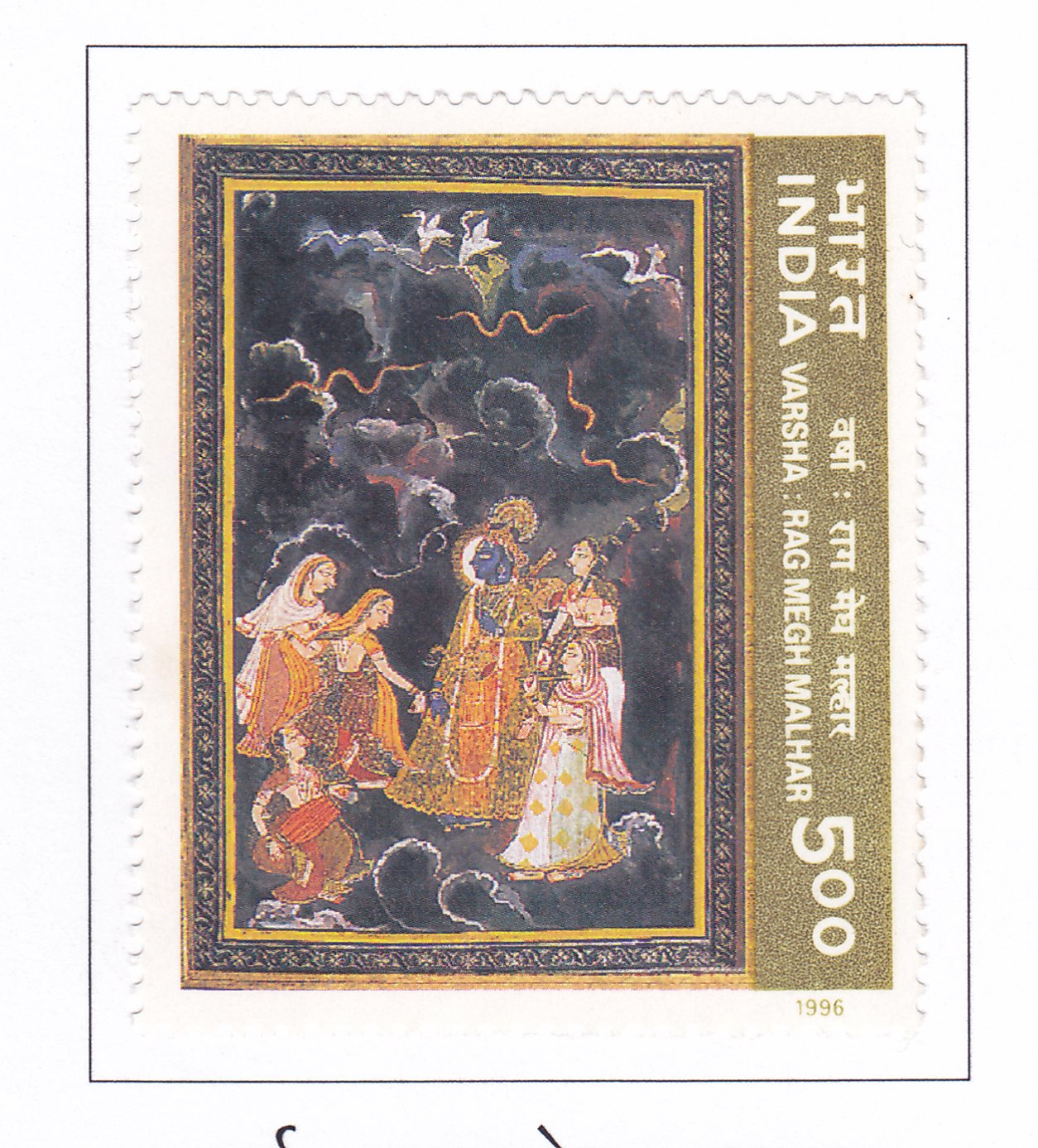Ritu Rang – “Varsha” (Monsoon) (Rag Megh Malbar)

Technical Data
| Stamp Set | Paintings of the Seasons |
|---|---|
| Date of Issue | March 13, 1996 |
| Denomination | Rs. 5 |
| Quantity | 1,000,000 |
| Perforation | comb 13½ |
| Printer | Security Printing Press, Nashik |
| Watermark | No Watermark |
| Colors | Multicolor |
| Catalog Codes |
Michel IN 1493 Stamp Number IN 1559 Yvert et Tellier IN 1301D Stanley Gibbons IN 1660 |
| Themes | Art | Paintings | Seasons |
Table of Contents
Ritu Rang – “Varsha”
The “Ritu Rang” series by India Post is a celebration of India’s rich tradition of miniature painting and its depiction of the seasons. This set of stamps captures the essence of Indian Miniature Art, showcasing the intricate and expressive style that has evolved over centuries.
Indian Miniature Painting: An Overview
Historical Background:
Indian Miniature Painting, with its origins in the Mughal era, represents a unique blend of Indo-Saracenic art. Initially, it depicted scenes from Mughal courts, but as the art form spread across regions like Kangra, Rajasthan, and the Deccan, it adopted local themes and styles. This regional diversification enriched the art form, resulting in various sub-schools that each contributed to its evolution.
Integration with Literature and Poetry:
The charm of Indian Miniature Painting is enhanced by its integration with literary works. Jayadeva’s “Gita Govinda” and Keshav Das’s “Kavipriya” and “Rasikpriya” are prime examples of how poetry and art merged to create vibrant and emotionally resonant visuals. These miniatures often depicted romantic and mystical themes, blending vivid colors with poetic expression.
Seasonal Depictions in Miniature Art:
The depiction of seasons has been a significant theme in Indian Miniature Painting, with each season represented through intricate and detailed artwork. The concept of the six seasons—Vasant (Spring), Greeshm (Summer), Varsha (Monsoon), Sharad (Autumn), Hemant (Winter), and Shishir (Late Winter)—is rooted in Kalidasa’s “Ritusamhara,” which celebrated the changing seasons through romantic and lyrical language.
“Ritu Rang” Stamps by India Post
The “Ritu Rang” stamp series highlights four key seasons through selected miniature paintings, each reflecting the essence of the depicted season:
- Vasant (Spring):
- Depiction: A painting on Rag Basanti, which embodies the spirit of spring.
- Essence: The artwork captures the vibrant renewal of spring, with floral motifs and bright, lively colors reflecting the season’s freshness.
- Greeshm (Summer):
- Depiction: Illustrates the intense heat of summer, with a warrior being deterred from his campaign due to the sweltering conditions.
- Essence: The painting portrays the harsh summer heat with a hazy atmosphere and subdued colors, emphasizing the season’s impact on daily life.
- Varsha (Monsoon):
- Depiction: Expressed in Rag Megh Malhar, this painting celebrates the monsoon rains and their life-giving qualities.
- Essence: The artwork features rain, lightning, and scenes of revelry, capturing the joy and renewal brought by the monsoons.
- Hemant (Winter):
- Depiction: The heart of winter, depicted with warmth provided by fire and the comfort of quilts.
- Essence: The painting portrays the cold, serene winter atmosphere, with cozy interiors and a sense of stillness.
Conclusion
The “Ritu Rang” stamp series by India Post is a tribute to the rich tradition of Indian Miniature Painting and its depiction of the seasons. Each stamp captures the unique characteristics of the season it represents, blending traditional art with poetic and natural themes. The first-day cover and cancellation design further enhance the beauty and significance of this special issue, celebrating India’s artistic heritage and its timeless appreciation of nature’s cycles.
